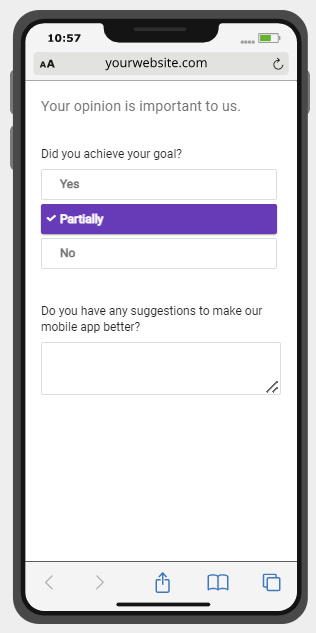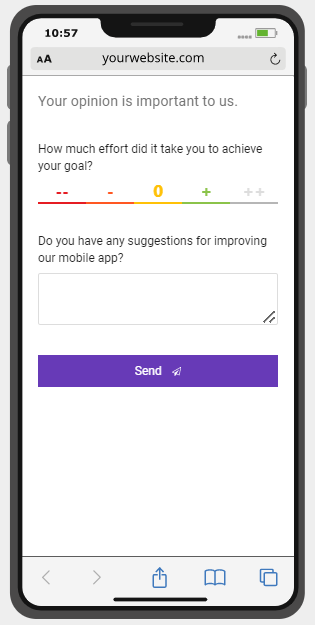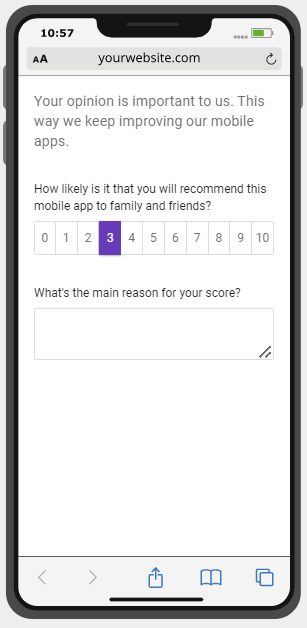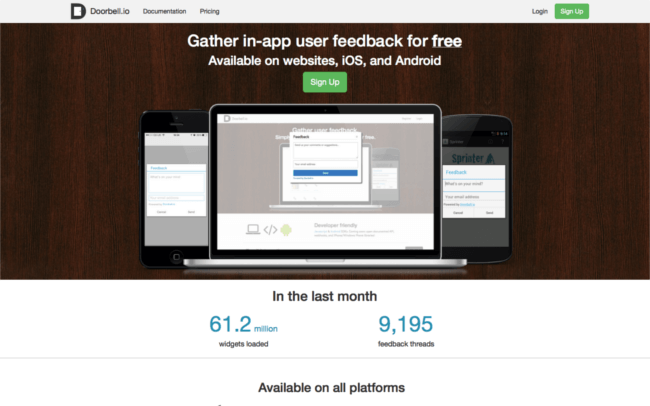Thanks to the convenience of mobile apps, many consumers are choosing the “easy route” and conducting more of their online activities in-app. In fact, according to DataReportal 2024, 88% of total mobile time is spent in apps rather than browsers.
This shift in behaviour has forced many organisations to lay a heavier focus on the mobile experience. That means gathering mobile feedback from their users on a regular basis.
Mobile app feedback not only helps paint a detailed picture of in-app customer behaviour but also sentiment. This type of customer feedback is however a bit different from website feedback and therefore requires a slightly different approach…
In this complete guide to mobile feedback, we will address the following:
- What is mobile feedback?
- Why is mobile feedback important?
- Methods for setting up mobile feedback
- Mobile app feedback survey templates
- Best mobile in-app feedback tools
Let’s get started.
What is mobile feedback?
Mobile app feedback is feedback collected directly from users inside your app, via surveys, ratings, or comments. It helps you understand both user behaviour and sentiment so you can improve your mobile experience.
The reason it can have a direct positive effect on your app experience, is because in addition to measuring hard metrics such as Net Promoter Score and CSAT, mobile feedback can also provide your organisation with the sentiment behind user behaviour.
This is done through mobile survey elements such as open comments. Qualitative data, like this, provides a deeper understanding of your mobile users, thus equipping your organisation with the means to cater more effectively to their needs.

Why is mobile app feedback important?
Providing a good mobile experience means having a user-friendly app that is attractive, easy to navigate, and purposeful.
Mobile app feedback is crucial because it helps improve user experience, retention, and product success. In fact, companies with strong app engagement see up to 5x higher retention rates.
In short, these are some of the benefits of mobile app feedback:
- Better onboarding – optimise how new users get started.
- Smarter feature launches – validate and adjust features quickly.
- Cost savings – avoid investing in the wrong developments.
- User insgihts – collect demographics, OS, and device info
- Bug tracking – screenshots + metadata help pinpoint issues.
Mobile app feedback vs Website feedback
Collecting user feedback helps optimise all digital channels, but websites and apps require different approaches. On websites, triggers like exit intent or mouse movement can launch feedback forms at the right moment. In apps, those triggers don’t exist, so you need mobile-specific solutions such as Webview, API, or SDK to capture in-app feedback effectively.
3 Methods for setting up mobile feedback
There are three different ways to collect mobile feedback. Which method you should choose depends on several factors. Is there technical knowledge in-house? Do you have enough time to build a solution yourself, etc.? To avoid too much technical talk, we will briefly explain the different methods for collecting mobile feedback below.
- What is Webview? It embeds a web-based form inside your app and it is easy to set up, but less native-looking.
- How does an API collect mobile feedback? Custom integration to display forms in-app, highly flexible, but needs developer resources.
- What is an SDK and why use it for feedback? Pre-built kit with advanced features (triggers, metadata, screenshots), most powerful, but requires integration effort.
As we mentioned, there are three different ways, all of which have their own advantages and disadvantages. For example, Mopinion’s SDKs allow the user to display a feedback form in the app based on user behaviour. This way the user can reach someone very purposefully and ask for feedback.
Curious how organisations like yours leverage user feedback?
Check out these customer stories
So what do these surveys look like in practice?
Try these Mobile Feedback Templates
There are a variety of different mobile feedback surveys your organisation can deploy in-app in order to gather meaningful mobile feedback. To help visualise how these might look we’ve put together a list of mobile feedback survey templates for you. Each of these mobile feedback templates leverages a different metric that caters to a different goal:
Mobile Feedback Template 1: Customer Satisfaction (CSAT)
Customer satisfaction is one of the top-scoring methods for businesses to measure brand loyalty. Collecting this feedback helps you measure how your brand (or services) are meeting your customers’ expectations. It is also very versatile, as you can use it to understand how customers value different aspects of your business.

*CSAT templates are ideal for gathering insights into your customers’ overall satisfaction with your mobile app.
Mobile Feedback Template 2: Goal Completion Rate (GCR)
Goal completion rate (GCR) is a customer experience metric that measures the number of visitors who completed, partially completed, or did not complete a specific goal within the mobile app.

In fact, it’s a great metric for those trying to optimise sales funnels or important processes like onboarding as it quickly reveals what your mobile users are struggling with.
Mobile Feedback Template 3: Customer Effort Score (CES)
Customer Effort Score (CES) is ideal for measuring customer success. CES measures how much effort it took your user to reach their goal. This is important to know because high effort typically leads to lower customer retention.
For example, poor customer satisfaction or usability may make your customer spend more effort than expected to achieve his/her goal.

Mobile Feedback Template 4: Net Promoter Score (NPS)
Net Promoter Score (NPS) is a very popular loyalty metric used by many companies. It serves as a good measure of your customers’ success. It measures how likely your customers are to recommend your business to others. The three main groupings in tracking NPS collectively include promoters (likely to recommend), passives (neutral) and detractors (not likely to recommend).

Note: it is important that this metric is only used for existing customers, or after a conversion (i.e. an in-app purchase). That way the customer has completed their journey and found themselves at the end of the funnel. With that experience, they can give you an accurate score.
Mobile Feedback Template 5: In-App Content Performance
Content has become a very critical part of mobile app design. And what many companies still don’t realise is that content strategies for mobile apps and websites couldn’t be more different. For example, many developers are still pushed to work with existing content (probably website content) for mobile app design.
This often presents a problem as this content introduces many pain points, e.g. too many characters/lines, long strings of text and visual aids/images that need to be adapted to a reduced screen size.

Do you want more examples? Check out our blog about mobile feedback templates here.
Best mobile in-app feedback tools
And then, of course, you’ll need a solution with which to create all of these great survey templates. Let’s take a look at some of the best mobile in-app feedback tools on the market:
1. Mopinion
Mopinion is an all-in-one user feedback software that specialises in in-app feedback. Users can capture feedback from your app users via our SDK’s, API or webview. It also includes a visual feedback feature that enables visitors to submit in-app screenshots alongside their feedback and metadata (i.e. user info, app version and more). All feedback captured via both web and mobile can then be visualised in your (customisable) dashboard in real-time. Mopinion is easily integrated with iOS and Android.
Interested? Start your free trial or request a demo
2. Alchemer

Alchemer Mobile, previously Apptentive, is a mobile in-app feedback tool that does in-app customer feedback, emotion data and key metrics in one dashboard. They also measure real-time shifts in emotion, focusing on improving retention rates. This tool collects both qualitative and quantitative data, which can be viewed in a dashboard on the platform.
Website: www.alchemer.com
3. Instabug

Instabug is a mobile in-app feedback tool as well as a bug detection tool that offers three main products: bug reporting, crash reporting and in-app chat. This tool facilitates a really smooth communication process between the user and the organisation as all communications are very direct. Some features Instabug offers include screenshot annotations, voice notes, screen recording, user profiles, network logging and third party integrations such as Slack, JIRA and Trello.
Website: www.instabug.com
4. Doorbell

Doorbell enables developers to collect and analyse elaborate, mobile in-app feedback from users. It provides users with instant notifications when they’ve received feedback by email or via the chat system. Visitors can also submit screenshots or attachments along with their feedback. All feedback you receive is automatically tagged using sentiment analysis, which classifies it as either positive or negative. This tool can be integrated with various project management software such as Pivotal Tracker, Asana, Trello, Sprint.ly and more.
Website: www.doorbell.io
5. Survicate

Survicate offers a nice mobile in-app feedback feature. It allows you to choose from single and multiple choice, text answer, smileys or NPS questions and set them up using skip logic for follow-ups and to engage with calls to action. Results are immediately sent to your reporting module or to your inbox. You can also choose to get instant notifications to your mobile.
Website: www.survicate.com
Check here for a complete list of mobile in-app feedback tools.
Time to go after those mobile insights!
We hope this guide has helped you or at least given you some inspiration for jump-starting your mobile feedback program. As you can see, there’s a lot to consider. But once your mobile feedback program is up and running, you’ll be glad you started.
Mobile feedback is so critical to the success of your app(s) and to creating a loyal customer base in the long run!
Start collecting mobile app feedback today with Mopinion!
Ready to see Mopinion in action?
Want to learn more about Mopinion’s all-in-1 user feedback platform? Don’t be shy and take our software for a spin! Do you prefer it a bit more personal? Just book a demo. One of our feedback pro’s will guide you through the software and answer any questions you may have.






